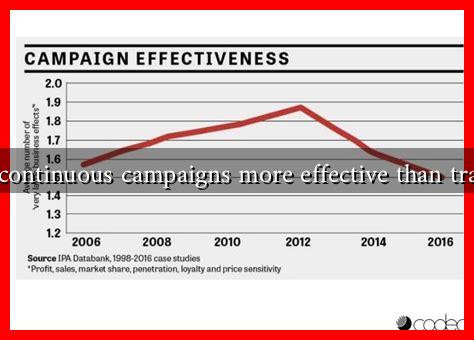-
Table of Contents
What Makes Continuous Campaigns More Effective Than Traditional Ones
In the ever-evolving landscape of marketing, businesses are constantly seeking innovative strategies to engage their audiences and drive conversions. One approach that has gained significant traction in recent years is the concept of continuous campaigns. Unlike traditional marketing campaigns, which are often time-bound and focused on short-term goals, continuous campaigns emphasize ongoing engagement and adaptability. This article explores the reasons why continuous campaigns are more effective than traditional ones, supported by relevant examples, case studies, and statistics.
Understanding Continuous Campaigns
Continuous campaigns are marketing efforts that are designed to run indefinitely, allowing brands to maintain a consistent presence in the market. These campaigns leverage data analytics, customer feedback, and real-time insights to adapt messaging and strategies on the fly. In contrast, traditional campaigns typically operate on a fixed schedule, often culminating in a single promotional push.
Key Advantages of Continuous Campaigns
Several factors contribute to the effectiveness of continuous campaigns over traditional ones:
- Ongoing Engagement: Continuous campaigns foster a deeper connection with audiences by maintaining regular communication. This ongoing engagement helps build brand loyalty and keeps the brand top-of-mind.
- Real-Time Adaptability: With continuous campaigns, marketers can quickly respond to market changes, customer preferences, and emerging trends. This flexibility allows for timely adjustments that can enhance campaign performance.
- Data-Driven Insights: Continuous campaigns rely heavily on data analytics to inform decision-making. By analyzing customer behavior and engagement metrics, marketers can optimize their strategies for better results.
- Cost Efficiency: While traditional campaigns often require significant upfront investment, continuous campaigns can be more cost-effective. By spreading marketing efforts over time, businesses can allocate resources more efficiently.
Case Studies: Success Stories of Continuous Campaigns
To illustrate the effectiveness of continuous campaigns, let’s examine a few successful examples:
- Coca-Cola: The “Share a Coke” campaign is a prime example of a continuous marketing effort. By personalizing bottles with popular names, Coca-Cola encouraged consumers to share their experiences on social media. This campaign not only increased sales but also fostered a sense of community among consumers.
- Netflix: Netflix employs continuous campaigns by constantly updating its content library and engaging users with personalized recommendations. This strategy keeps subscribers engaged and reduces churn rates, as users feel that there is always something new to watch.
- Amazon: Amazon’s continuous campaign approach is evident in its Prime membership program. By consistently adding value through exclusive deals, free shipping, and original content, Amazon keeps its customers engaged year-round.
Statistics Supporting Continuous Campaigns
Several studies highlight the effectiveness of continuous campaigns:
- A report by HubSpot found that companies with ongoing marketing campaigns see a 50% higher engagement rate compared to those with traditional campaigns.
- According to a study by the Content Marketing Institute, 70% of marketers believe that continuous campaigns lead to better customer retention.
- Research from McKinsey indicates that brands that engage in continuous marketing efforts can achieve up to 30% higher ROI compared to traditional campaign strategies.
Challenges of Continuous Campaigns
While continuous campaigns offer numerous advantages, they are not without challenges:
- Resource Intensive: Continuous campaigns require ongoing investment in content creation, data analysis, and customer engagement strategies.
- Maintaining Consistency: Brands must ensure that their messaging remains consistent across all channels, which can be challenging over time.
- Adapting to Change: The need for real-time adaptability can lead to confusion if not managed properly, as teams must be agile and responsive to market shifts.
Conclusion
In conclusion, continuous campaigns represent a significant evolution in marketing strategy, offering brands the ability to engage with their audiences in a more meaningful and effective way. By fostering ongoing engagement, leveraging data-driven insights, and maintaining flexibility, businesses can achieve better results than with traditional campaigns. As the marketing landscape continues to evolve, embracing continuous campaigns may be essential for brands looking to thrive in a competitive environment.
For more insights on effective marketing strategies, consider exploring resources from HubSpot and Content Marketing Institute.

